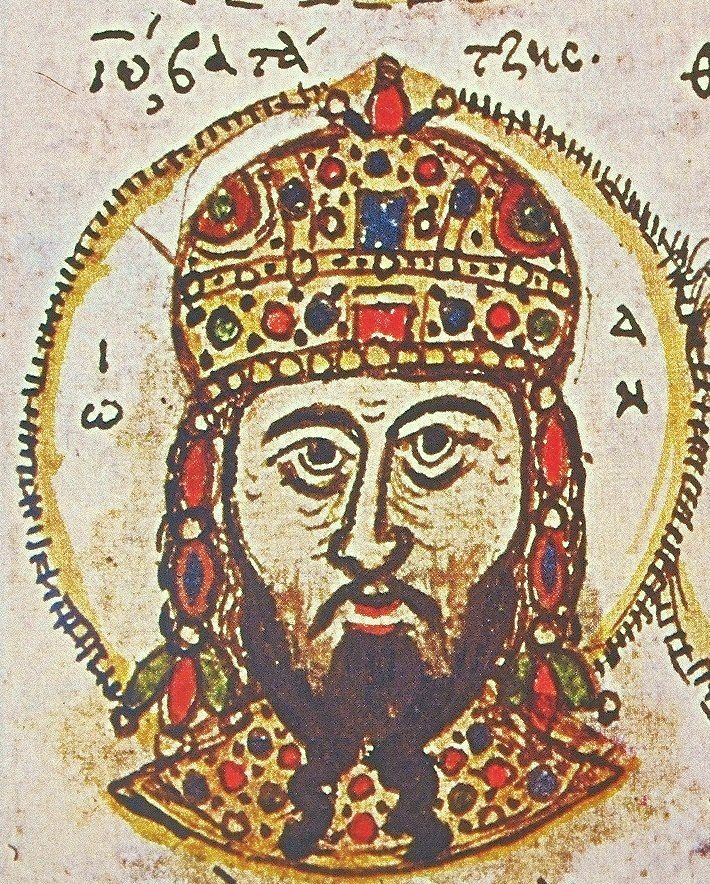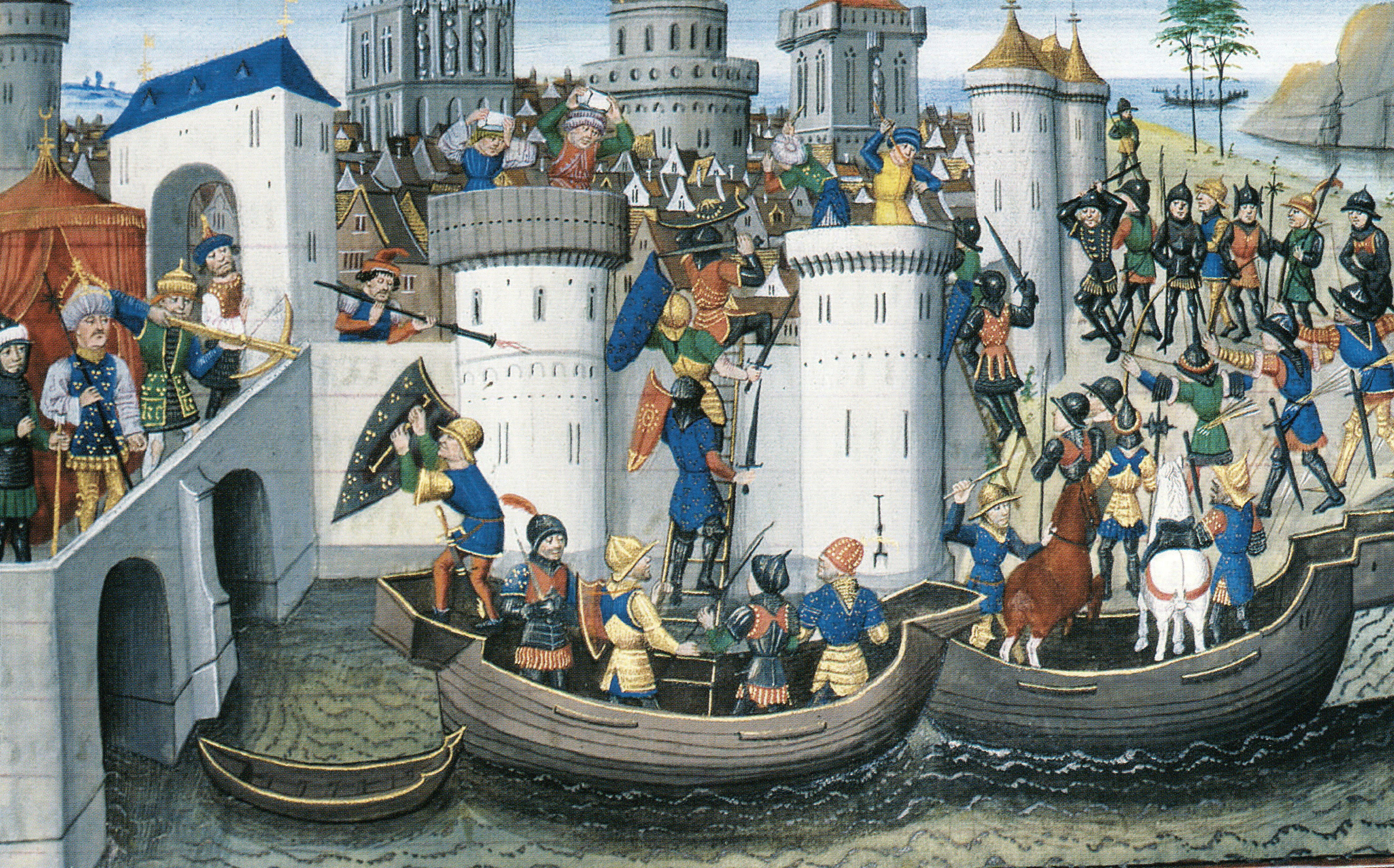|
Nicaean–Latin Wars
The Nicaean–Latin wars were a series of wars between the Latin Empire and the Empire of Nicaea, starting with the dissolution of the Byzantine Empire by the Fourth Crusade in 1204. The Latin Empire was aided by other Crusader states established on Byzantine territory after the Fourth Crusade, as well as the Republic of Venice, while the Empire of Nicaea was assisted occasionally by the Second Bulgarian Empire, and sought the aid of Venice's rival, the Republic of Genoa. The conflict also involved the Greek state of Epirus, which also claimed the Byzantine inheritance and opposed Nicaean hegemony. The Nicaean reconquest of Constantinople in 1261 AD and the restoration of the Byzantine Empire under the Palaiologos dynasty did not end the conflict, as the Byzantines launched on and off efforts to reconquer southern Greece (the Principality of Achaea and the Duchy of Athens) and the Aegean islands until the 15th century, while the Latin powers, led by the Angevin Kingdom of Naples, t ... [...More Info...] [...Related Items...] OR: [Wikipedia] [Google] [Baidu] |
Entry Of The Crusaders In Constantinople
Entry may refer to: * Entry, West Virginia, an unincorporated community in the United States * Entry (cards), a term used in trick-taking card-games * Entry (economics), a term in connection with markets * ''Entry'' (film), a 2013 Indian Malayalam film *Entry, occurrence of a repeated musical theme, especially in a fugue In music, a fugue () is a contrapuntal compositional technique in two or more voices, built on a subject (a musical theme) that is introduced at the beginning in imitation (repetition at different pitches) and which recurs frequently in the c ... See also * Enter (other) * Entrance (other) * * {{disambiguation ... [...More Info...] [...Related Items...] OR: [Wikipedia] [Google] [Baidu] |
John I Doukas
John I Doukas ( gr, Ἰωάννης Δούκας, Iōánnēs Doúkas), Latinized as Ducas, was an illegitimate son of Michael II Komnenos Doukas, Despot of Epirus in –1268. After his father's death, he became ruler of Thessaly from to his own death in 1289. From his father's family he is also inaccurately known as John Angelos. Married to a Thessalian Vlach woman, John first appears leading Vlach troops alongside his father in the lead-up to the Battle of Pelagonia in 1259. His defection to the camp of Emperor Michael VIII Palaiologos was crucial in the battle, which ended with the crushing defeat of the Epirotes' Latin allies and opened the way for the recovery of Constantinople and the re-establishment of the Byzantine Empire under Palaiologos in 1261. John quickly returned to the side of his father and brother, Nikephoros, and assisted them in recovering Epirus and Thessaly. After Michael II died, John Doukas became ruler of Thessaly with his seat at Neopatras, whence Wes ... [...More Info...] [...Related Items...] OR: [Wikipedia] [Google] [Baidu] |
Ivan Asen II
Ivan Asen II, also known as John Asen II ( bg, Иван Асен II, ; 1190s – May/June 1241), was Emperor (Tsar) of Bulgaria from 1218 to 1241. He was still a child when his father Ivan Asen I one of the founders of the Second Bulgarian Empire was killed in 1196. His supporters tried to secure the throne for him after his uncle, Kaloyan, was murdered in 1207, but Kaloyan's other nephew, Boril, overcame them. Ivan Asen fled from Bulgaria and settled in the Rus' principalities. Boril could never strengthen his rule which enabled Ivan Asen to muster an army and return to Bulgaria. He captured Tarnovo and blinded Boril in 1218. Initially, he supported the full communion of the Bulgarian Church with the Papacy and concluded alliances with the neighboring Catholic powers, Hungary and the Latin Empire of Constantinople. He tried to achieve the regency for the 11-year-old Latin Emperor, Baldwin II, after 1228, but the Latin aristocrats did not support Ivan Asen. He inflicted a ... [...More Info...] [...Related Items...] OR: [Wikipedia] [Google] [Baidu] |
Alexios Strategopoulos
Alexios Komnenos Strategopoulos ( gr, Ἀλέξιος Κομνηνὸς Στρατηγόπουλος) was a Byzantine aristocrat and general who rose to the rank of ''megas domestikos'' and ''Caesar''. Distantly related to the Komnenian dynasty, he appears in the sources already at an advanced age in the early 1250s, leading armies for the Empire of Nicaea against Epirus. After falling out of favour and being imprisoned by Theodore II Laskaris, Strategopoulos sided with the aristocrats around Michael VIII Palaiologos, and supported him in his rise to the throne after Theodore II's death in 1258. He participated in the Pelagonia campaign in 1259, going on to capture Epirus, but his successes were undone in the next year and he was captured by the Epirotes. Released after a few months, he led the unexpected reconquest of Constantinople from the Latin Empire in July 1261, restoring the Byzantine Empire. He was captured again by the Epirotes in the next year and spent several years i ... [...More Info...] [...Related Items...] OR: [Wikipedia] [Google] [Baidu] |
John Palaiologos (brother Of Michael VIII)
John Doukas Palaiologos ( el, , 1225/30 – 1274) was a Byzantine aristocrat, brother to Emperor Michael VIII Palaiologos (r. 1259–1282), who served as the commander-in-chief of the Byzantine army. He played a prominent part in his brother's military campaigns, most notably in the crucial victory at the Battle of Pelagonia, but also in repeated campaigns against Epirus and against the Turks in Asia Minor. He retired from active service after his defeat at Neopatras, and died shortly after. Biography Early life and first successes John Doukas Palaiologos was born sometime after 1225 and before 1230, the son of Andronikos Palaiologos, the ''megas domestikos'' of the Empire of Nicaea, and his first wife Theodora Palaiologina. John was their second son, after the future emperor Michael Palaiologos, and the fourth child overall. Nothing is known of him until 1256, when he appears to have been sent to Rhodes. The reasons for this is unclear; possibly to take charge of the military ... [...More Info...] [...Related Items...] OR: [Wikipedia] [Google] [Baidu] |
Michael VIII Palaiologos
Michael VIII Palaiologos or Palaeologus ( el, Μιχαὴλ Δούκας Ἄγγελος Κομνηνὸς Παλαιολόγος, Mikhaēl Doukas Angelos Komnēnos Palaiologos; 1224 – 11 December 1282) reigned as the co-emperor of the Empire of Nicaea from 1259 to 1261, and as Byzantine emperor from 1261 until his death in 1282. Michael VIII was the founder of the Palaiologan dynasty that would rule the Byzantine Empire until the Fall of Constantinople in 1453. He recovered Constantinople from the Latin Empire in 1261 and transformed the Empire of Nicaea into a restored Byzantine Empire. His reign saw considerable recovery of Byzantine power, including the enlargement of the Byzantine army and navy. It would also include the reconstruction of the city of Constantinople, and the increase of its population. Additionally, he re-established the University of Constantinople, which led to what is regarded as the Palaiologan Renaissance between the 13th and 15th centuries. It was ... [...More Info...] [...Related Items...] OR: [Wikipedia] [Google] [Baidu] |
Theodore II Laskaris
Theodore II Doukas Laskaris or Ducas Lascaris ( gr, Θεόδωρος Δούκας Λάσκαρις, Theodōros Doukas Laskaris; 1221/1222 – 16 August 1258) was Emperor of Nicaea from 1254 to 1258. He was the only child of Emperor John III Doukas Vatatzes and Empress Irene Laskarina. His mother was the eldest daughter of Theodore I Laskaris who had established the Empire of Nicaea as a successor state to the Byzantine Empire in Asia Minor, after the crusaders captured the Byzantine capital, Constantinople, during the Fourth Crusade in 1204. Theodore received an excellent education from two renowned scholars, Nikephoros Blemmydes and George Akropolites. He made friends with young intellectuals, especially with a page of low birth, George Mouzalon. Theodore began to write treatises on theological, historical and philosophical themes in his youth. Emperor John III arranged for Theodore to marry Elena of Bulgaria in 1235, to forge an alliance with her father, Ivan ... [...More Info...] [...Related Items...] OR: [Wikipedia] [Google] [Baidu] |
John III Doukas Vatatzes
John III Doukas Vatatzes, Latinized as Ducas Vatatzes ( el, Ιωάννης Δούκας Βατάτζης, ''Iōannēs Doukas Vatatzēs'', c. 1192 – 3 November 1254), was Emperor of Nicaea from 1221 to 1254. He was succeeded by his son, known as Theodore II Laskaris. Life John Doukas Vatatzes, born in about 1192 in Didymoteicho, was probably the son of the general Basil Vatatzes, who was killed in battle in 1194, and his wife, a cousin of the Emperors Isaac II Angelos and Alexios III Angelos. John Doukas Vatatzes had two older brothers. The eldest was Isaac Doukas Vatatzes (1188-1261), while his younger brother died young. Through his marriage to Eudokia Angelina he fathered Theodora Doukaina Vatatzaina, who later married Michael VIII Palaiologos. The middle brother's name is unknown, but his daughter married the ''protovestiarios'' Alexios Raoul. A successful soldier from a military family, John was chosen in about 1216 by Emperor Theodore I Laskaris as the second husband ... [...More Info...] [...Related Items...] OR: [Wikipedia] [Google] [Baidu] |
Theodore I Laskaris
Theodore I Laskaris or Lascaris ( gr, Θεόδωρος Κομνηνὸς Λάσκαρις, Theodōros Komnēnos Laskaris; 1175November 1221) was the first emperor of Nicaea—a successor state of the Byzantine Empire—from 1205 to his death. Although he was born to an obscure aristocratic family, his mother was related to the imperial Komnenos clan. He married Anna, a younger daughter of Emperor Alexios III Angelos in 1200. He received the title of despot before 1203, demonstrating his right to succeed his father-in-law on the throne. The Fourth Crusade forced AlexiosIII to flee from Constantinople in 1203. Theodore was imprisoned by the crusaders (commonly referred to as " Latins" by the Byzantines), but he escaped. After crossing the Bosporus into Asia Minor (in present-day Turkey), he started to organise the local Greeks' resistance against the Latins in Bithynia in his father-in-law's name. He concluded an alliance with the Seljuq sultan of Rum, but he could ... [...More Info...] [...Related Items...] OR: [Wikipedia] [Google] [Baidu] |
Despotate Of Epirus
The Despotate of Epirus ( gkm, Δεσποτᾶτον τῆς Ἠπείρου) was one of the Greek successor states of the Byzantine Empire established in the aftermath of the Fourth Crusade in 1204 by a branch of the Angelos dynasty. It claimed to be the legitimate successor of the Byzantine Empire, along with the Empire of Nicaea and the Empire of Trebizond, its rulers briefly proclaiming themselves as Emperors in 1227–1242 (during which it is most often called the Empire of Thessalonica). The term "Despotate of Epirus" is, like "Byzantine Empire" itself, a modern historiographic convention and not a name in use at the time. The Despotate was centred on the region of Epirus, encompassing also Albania and the western portion of Greek Macedonia and also included Thessaly and western Greece as far south as Nafpaktos. Through a policy of aggressive expansion under Theodore Komnenos Doukas the Despotate of Epirus also briefly came to incorporate central Macedonia, with the es ... [...More Info...] [...Related Items...] OR: [Wikipedia] [Google] [Baidu] |
Republic Of Venice
The Republic of Venice ( vec, Repùblega de Venèsia) or Venetian Republic ( vec, Repùblega Vèneta, links=no), traditionally known as La Serenissima ( en, Most Serene Republic of Venice, italics=yes; vec, Serenìsima Repùblega de Venèsia, links=no), was a sovereign state and Maritime republics, maritime republic in parts of present-day Italy (mainly Northern Italy, northeastern Italy) that existed for 1100 years from AD 697 until AD 1797. Centered on the Venetian Lagoon, lagoon communities of the prosperous city of Venice, it incorporated numerous Stato da Màr, overseas possessions in modern Croatia, Slovenia, Montenegro, Greece, Albania and Cyprus. The republic grew into a Economic history of Venice, trading power during the Middle Ages and strengthened this position during the Renaissance. Citizens spoke the still-surviving Venetian language, although publishing in (Florentine) Italian became the norm during the Renaissance. In its early years, it prospered on the salt ... [...More Info...] [...Related Items...] OR: [Wikipedia] [Google] [Baidu] |


.jpg)

.png)


